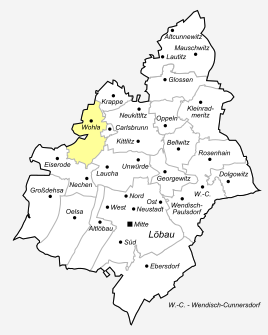Wohla (Löbau)
|
Wohla
City of Löbau
Coordinates: 51 ° 8 ′ 20 " N , 14 ° 38 ′ 40" E
|
|
|---|---|
| Area : | 2.55 km² |
| Incorporation : | April 1, 1974 |
| Incorporated into: | Kittlitz |
| Postal code : | 02708 |
| Area code : | 03585 |
|
Location of Wohla in the area of the city of Löbau
|
|
Wohla ( Upper Sorbian Walowy ) is a district of Löbau in Upper Lusatia .
geography
The village is located at an altitude of 280 to 300 meters on the southeast slope of the Wohlaer Berg on the road from Breitendorf to Kittlitz . The Munschke settlement , the windmill farm and the wasteland of Africa belong to the 255 hectare district .
history
The name of the place is derived from the Upper Sorbian word wola (= "will", formerly also "freedom"). In 1348 the village was first called "whale". In 1390 the village of "Wole" was placed under the jurisdiction of the city of Löbau. In 1481 the place was called "zu Wale". The owner of the Allodialgut Wohla was the church in Kittlitz until 1535. The estate was the residence of the Kittlitz pastors. In 1535 the church exchanged the property at the rule of Kittlitz for ten Malter land. Later the von Kittlitz family on Kittlitz divided the Wohla estate with the von Nostitz family on Lautitz in two halves. In 1679 Ernst von Ziegler and Klipphausen bought one of the shares on Nostitz. This was not only subject to the manor Nostitz , but also assigned to the new Nostitz church trip. Until 1945 there was a manor with 125 hectares of land in Wohla. On April 1, 1974, Wohla was incorporated into Kittlitz. Together with Kittlitz, it was incorporated into Löbau on January 1, 2003.
Population and language
In the 19th century, Sorbs still lived in Wohla . For his statistics on the Sorbian population in Upper Lusatia, Arnošt Muka determined a population of 154 inhabitants in the 1880s; including 112 Sorbs (73%) and 42 Germans. Wohla was then on the eastern edge of the Sorbian majority area. The Löbauer dialect of Upper Sorbian, now extinct, was spoken in the village . The language change to German took place here at the beginning of the 20th century. In 1956 Ernst Tschernik only had nine speakers. Today the Sorbian has disappeared from everyday life.
Wohla Castle
The castle was built around 1750. The simple solid construction with a steep hipped roof and seven-window facade now serves as a hotel. A sandstone Bacchus stands at the castle .
Windmill
A small Dutch windmill has stood northeast of the village since 1808 . It was converted from wind power to diesel power in 1912. In 1926 the wings were removed. Electric propulsion began in 1944.
literature
- Between Strohmberg, Czorneboh and Kottmar (= values of our homeland . Volume 24). 1st edition. Akademie Verlag, Berlin 1974.
- Cornelius Gurlitt : Wohla. In: Descriptive representation of the older architectural and art monuments of the Kingdom of Saxony. 34. Issue: Official Authority Löbau . CC Meinhold, Dresden 1910, p. 590.
Web links
- Information about Wohla on the website of the city of Löbau
- Private website about Wohla
- Pictures from Wohla
- Wohla in the Digital Historical Directory of Saxony
Individual evidence
- ↑ Municipalities 1994 and their changes since January 1, 1948 in the new federal states , Metzler-Poeschel publishing house, Stuttgart, 1995, ISBN 3-8246-0321-7 , publisher: Federal Statistical Office
- ^ StBA: Changes in the municipalities in Germany, see 2003
- ↑ Ernst Tschernik: The development of the Sorbian population . Akademie-Verlag, Berlin 1954.
- ^ Ludwig Elle: Language policy in the Lausitz . Domowina-Verlag, Bautzen 1995, p. 253 .



